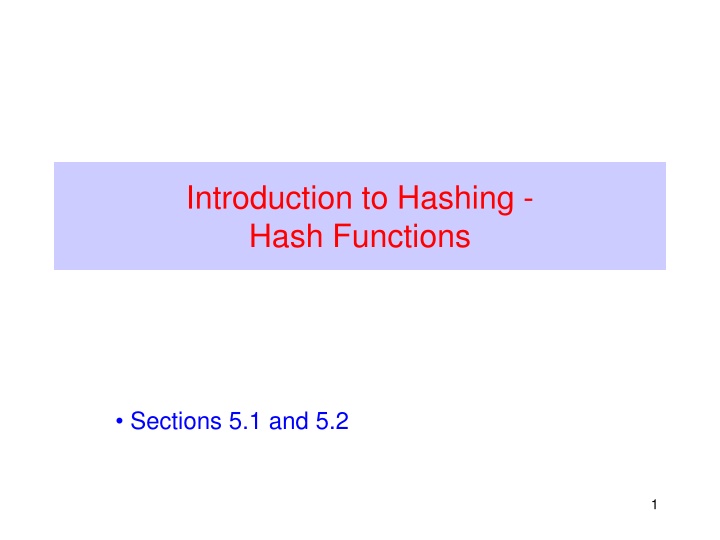
Hashing Functions and Applications
Explore the concepts of hashing functions, hash tables, collision management, and efficient data storage methods. Learn how hash functions map keys to integers, handle collisions, and achieve evenly distributed index values. Discover the applications of hash tables in various fields, from compilers to game programs.
Uploaded on | 0 Views
Download Presentation

Please find below an Image/Link to download the presentation.
The content on the website is provided AS IS for your information and personal use only. It may not be sold, licensed, or shared on other websites without obtaining consent from the author. If you encounter any issues during the download, it is possible that the publisher has removed the file from their server.
You are allowed to download the files provided on this website for personal or commercial use, subject to the condition that they are used lawfully. All files are the property of their respective owners.
The content on the website is provided AS IS for your information and personal use only. It may not be sold, licensed, or shared on other websites without obtaining consent from the author.
E N D
Presentation Transcript
Introduction to Hashing - Hash Functions Sections 5.1 and 5.2 1
Hashing Data items are stored in an array of some fixed size Hash table Search performed using some part of the data item key Used for performing insertions, deletions, and finds in constant average time Operations requiring ordering information not supported efficiently Such as findMin, findMax 2
Applications of hash tables Comparing search efficiency of different data structures: Vector, list: O(N) Binary search tree: O(log(N)) Hash table: O(1) Compilers to keep track of declared variables Symbol tables Mapping from name to id Game programs to keep track of positions visited Transposition table On-line spelling checkers BTW, a fast way to solve the word puzzle problem is to use hash table to maintain the valid words Examples/r7 4
Hashing functions Map keys to integers (which represent table indices) Hash(Key) = Integer Evenly distributed index values Even if the input data is not evenly distributed What happens if multiple keys mapped to the same integer (same position)? Collision management (discussed in detail later) 5
Simple Hash Functions Assumptions: K: an unsigned 32-bit integer M: the number of buckets (the number of entries in a hash table) Goal: If a bit is changed in K, all bits are equally likely to change for Hash(K) So that items evenly distributed in hash table 6
A Simple Function What if Hash(K) = K % M Where M is of any integer value What is wrong? Values of K may not be evenly distributed But Hash(K) needs to be evenly distributed Suppose M = 10, K = 10, 20, 30, 40 Then K % M = 0, 0, 0, 0, 0 7
Another Simple Function If Hash(K) = K % P, P = prime number Suppose P = 11 K = 10, 20, 30, 40 K % P = 10, 9, 8, 7 More uniform distribution So hash tables have prime number of entries 8
Hashing a Sequence of Keys K = {K1, K2, , Kn) E.g., Hash( test ) = 98157 Design Principles Use the entire key Use the ordering information 9
Use the Entire Key unsigned int Hash(const string& Key) { unsigned int hash = 0; for (string::size_type j = 0; j != Key.size(); ++j) { hash = hash ^ Key[j] // exclusive or } return hash; } Problem: Hash( ab ) == Hash( ba ) 10
Use the Ordering Information unsigned int Hash(const string &Key) { unsigned int hash = 0; for (string::size_type j = 0; j != Key.size(); ++j) { hash = hash ^ Key[j]; hash = hash * (j%32); } return hash; } 11
Better Hash Function unsigned int Hash(const string& S) { string::size_type i; long unsigned int bigval = S[0]; for (i = 1; i < S.size(); ++i) bigval = ((bigval & 65535) * 18000) // low16 * magic_number + (bigval >> 16) // high16 + S[i]; /* some values: f(a) = 42064 f(b) = 60064 f(abcd) = 41195 f(bacd) = 39909 f(dcba) = 29480 f(x) = 62848 f(xx) = 44448 f(xxx) = 15118 f(xxxx) = 28081 f(xxxxx) = 45865 */ } bigval = ((bigval & 65535) * 18000) + (bigval >> 16); // bigval = low16 * magic_number + high16 return bigval & 65535; // return low16 12
